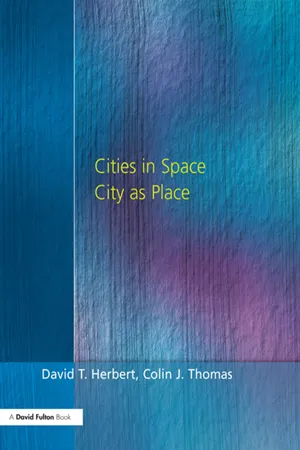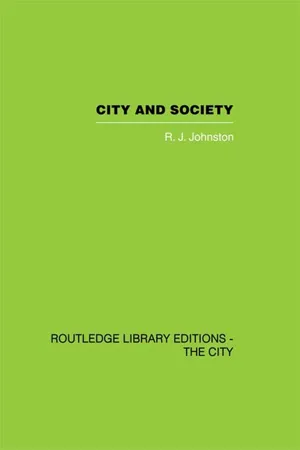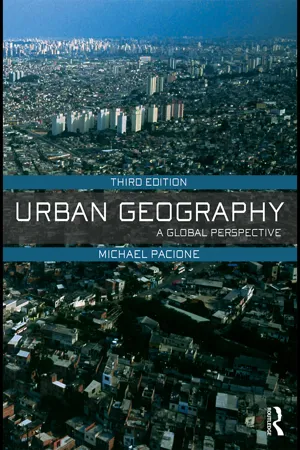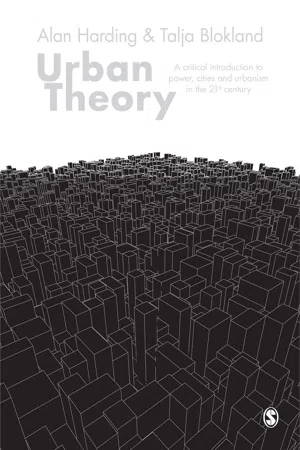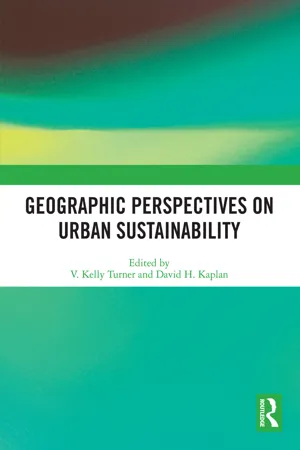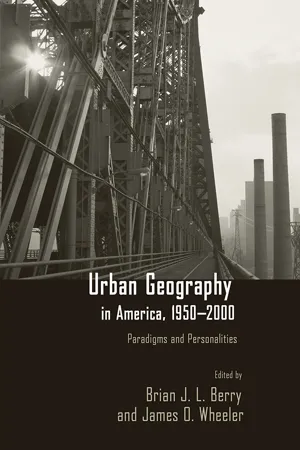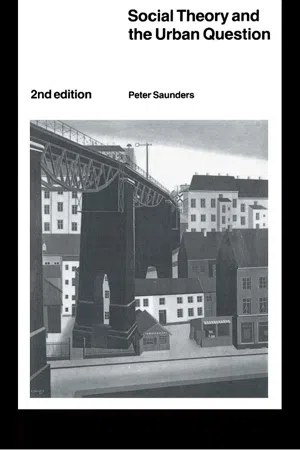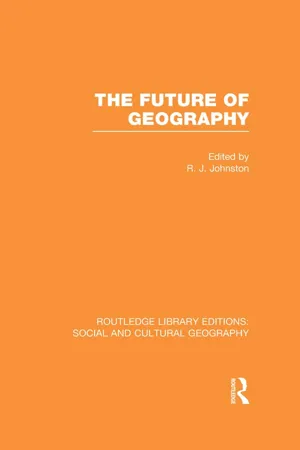Geography
Urban Geography
Urban geography is the study of cities and urban areas, focusing on their spatial organization, social and economic processes, and environmental impacts. It examines the patterns of urban development, land use, transportation, and the distribution of resources within urban areas. Urban geography also explores the interactions between people and the built environment in urban settings.
Written by Perlego with AI-assistance
Related key terms
11 Key excerpts on "Urban Geography"
- eBook - ePub
Urban Geography (Routledge Revivals)
An Introductory Guide
- David Clark(Author)
- 2013(Publication Date)
- Routledge(Publisher)
Geography is scientific in so far as it aims to develop general rather than unique explanations of spatial patterns and distributions. It proceeds from the assumption that there is basic regularity and uniformity in the location and occurrence of phenomena and that this order can be identified and accounted for by geographical analysis. In examining spatial structure, geography focuses upon those distributional characteristics that are common to a wide range of phenomena. To this end, emphasis in geographical study is placed upon models and theories of location rather than upon descriptions of individual features. The overriding aim is to develop an understanding of the general principles which determine the location of human and physical characteristics.Urban Geography is that branch of geography that concentrates upon the location and spatial arrangement of towns and cities. It seeks to add a spatial dimension to our understanding of urban places and urban problems. Urban geographers are concerned to identify and account for the distribution of towns and cities and the spatial similarities and contrasts that exist within and between them. They are concerned with both the contemporary urban pattern and with the ways in which the distribution and internal arrangement of towns and cities have changed over time. Emphasis in Urban Geography is directed towards the understanding of those social, economic and environmental processes that determine the location, spatial arrangement and evolution of urban places. In this way, geographical analysis both supplements and complements the insights provided by allied disciplines in the social and environmental sciences which recognise the city as a distinctive focus of study.Types of Urban Geographical StudyThe scope and nature of Urban Geography is best illustrated by reference to the data on towns and cities that typically form the starting point for urban geographical study. Two basic types of data are in fact necessary to summarise the geographical characteristics of urban places, the one relating to land using activities such as population, housing and industry, the other to the different types of exchange, linkage and interaction which take place within and between centres (Figure 1.1 - eBook - ePub
Cities In Space
City as Place
- Prof David Herbert, Dr Colin Thomas(Authors)
- 2013(Publication Date)
- David Fulton Publishers(Publisher)
Space, Figure 1.2 Subdisciplines of human geography for example, was central to the positive science of spatial analysis, place is the key concept for a humanistic and cultural approach, and environment was both a focus of earlier approaches and a new concern of studies of the sustainable city. A definition of Urban Geography, developed with reference to the discipline as a whole and recent experience of actual research, is Urban Geography studies the patterns and processes which occur between and within urban places; the objective form which these take, the subjective manner in which they are interpreted, and their mode of origin at both local and societal scales. Among the subdivisions of human geography, Urban Geography sits somewhat uneasily as Figure 1.2 shows. Whereas economic geography and social geography are distinguished by thematic concerns, Urban Geography studies an area. Frey (1973) commented on this type of issue with the suggestion that geography considered both single elements or topics which could be studied systematically, or assemblages of areas which could be studied regionally. As an area-based study, an Urban Geography can cover a catholicity of interest. More commonly, however, studies of individual cities focus upon historical, economic, social and political aspects and have some specialist interest. Urban Geography consists of a range of studies of different aspects of the city as a human place and is centrally concerned with those economic, social and political forces that find expression in urban areas. In modern terms these characteristics serve the subdiscipline well. The analysis of ‘the city’ gives it a holistic approach, as much concerned with interactions as with the separate strands of urban life - eBook - ePub
City and Society
An Outline for Urban Geography
- R.J. Johnston(Author)
- 2013(Publication Date)
- Routledge(Publisher)
1. The Concerns of Urban GeographyGeography is generally accepted by its practitioners as ‘that discipline that seeks to describe and interpret the variable character from place to place of the earth as the world of man’;* Urban Geography attempts such description and interpretation for those parts of the earth's surface classified as urban places. There is no universal definition of urban places. The usual criterion is that an urban area should be a nucleation of settlement in which the great majority of the population is not employed in agriculture. Most statistical agencies set a population size threshold below which such a nucleation is not considered urban. But the majority of urban places are large and the majority of urban dwellers live in big towns and cities. A precise definition is of little relevance except for detailed statistical comparisons, therefore; in this book, the terms ‘town’ and ‘city’ are used interchangeably to apply to any non-agricultural settlement containing more than a few hundred inhabitants.As a recognizable sub-discipline, Urban Geography is a relatively recent development; the first textbook on the topic in English, for example, was not published until the 1940s. Growth has been rapid in recent decades, however, and Urban Geography is now a major sub-discipline. The reasons for this late development are not entirely clear, for towns have long been salient features of the landscape. Until the decades after the Second World War much geographical work was concerned with the evolution of landscapes, especially rural landscapes, with a focus on human artifacts rather than on the humans themselves.Some work on urban areas was done in this genre, emphasizing, for example, the importance of site and situation as influences on urban fortunes. Geographical interest in the definition of regions, areas with common characteristics, led to work on the hinterlands of towns, the areas for which they were the trading nexus, and on morphological regions within towns and cities, as reflected by street patterns, building types and materials, and building uses; interest in the townscape was slight, however, in comparison to the volume of work on the rural landscape. Before 1950 very few academic members of the discipline would have called themselves urban geographers, and it was only a change of emphasis in geography as a whole after about 1955 that made the urban place a major focus of academic research. - eBook - ePub
Urban Geography
A Global Perspective
- Michael Pacione(Author)
- 2009(Publication Date)
- Routledge(Publisher)
PART ONE The Study of Urban Geography 1 Urban Geography from global to local Preview: the study of Urban Geography; global triggers of urban change—economy, technology, demography, politics, society, culture, environment; globalisation; localisation of the global; the meaning of geographic scale; local and historical contingency; processes of urban change; urban outcomes; why study Urban Geography? INTRODUCTION Urban Geography seeks to explain the distribution of towns and cities and the socio-spatial similarities and contrasts that exist between and within them. If all cities were unique, this would be an impossible task. However, while every town and city has an individual character, urban places also exhibit common features that vary only in degree of incidence or importance within the particular urban fabric. All cities contain areas of residential space, transportation lines, economic activities, service infrastructure, commercial areas and public buildings. In different world regions the historical process of urban evolution may have followed a similar trajectory. Increasingly, similar processes, such as those of suburbanisation, gentrification and socio-spatial segregation, are operating within cities in the developed world, in former communist states and in countries of the Third World to effect a degree of convergence in the nature of urban landscapes. Cities also exhibit common problems to varying degrees, including inadequate housing, economic decline, poverty, ill health, social polarisation, traffic congestion and environmental pollution. In brief, many characteristics and concerns are shared by urban places. These shared characteristics and concerns represent the foundations for the study of Urban Geography - eBook - ePub
Urban Theory
A critical introduction to power, cities and urbanism in the 21st century
- Alan Harding, Talja Blokland(Authors)
- 2014(Publication Date)
- SAGE Publications Ltd(Publisher)
1 What is urban theory?Learning objectives
- To understand the conceptual dilemmas that come with attempts to define ‘the urban’
- To see how classical scholars have thought about the urban and rural in the context of modernity
- To understand what ‘theory’ is and learn about the various epistemological and ontological perspectives that inform theory
Urban studies and urban theory
People are entitled to be confused, even a little intimidated, by the way towns and cities are studied today. Contemporary courses in urban studies cover just about every conceivable aspect of the urban experience. Some approaches are relatively self-contained and coherent, but most tend to shade into each other. In an age in which more than half of the global population is living in urban areas for the first time in human history, there are no easily defined conceptual boundaries that can allow us to designate everything on one side of an imaginary line as urban studies and everything on the other side as something else. Neither are urban studies the property of a single academic discipline. Claims are made for a distinctive urban sociology, an urban politics, geography, economics, planning and so on, but in practice it is hard to distinguish one from another. The ‘urban’ components of these disciplines are not very self-contained either. It is difficult, for example, to say what differentiates Urban Geography from human geography, or urban sociology from more general social theory. And it is far from clear which of the standard academic disciplines ‘owns’ the more specific subject matter that often surfaces in the literature; urban architecture, conservation, design, ecology, economic development, environment, landscape, management, morphology, policy and so on.Urban subdisciplines
Urban studies are eclectic; they bring together and build upon knowledge, understandings and approaches from a wide range of subject areas. Recounting his experience of urban sociology as an undergraduate in 1970, Peter Saunders could remember little coherence in his chosen course of study other than the fact that ‘if you could find it happening in cities, then you could find it discussed somewhere in the … literature’ (Saunders, 1986: 7). Little has changed since Saunders’ undergraduate days in this respect. If anything, urban studies have become still more eclectic and fragmented. So, for example, it has been argued that Saunders’ field concerns itself with the following: how the urban experience feels; if and how places acquire distinctive identities; how urban life is affected by a person’s gender, class, and ethnic group or the sort of housing he/she lives in; the effect of different urban environments on social relationships and bonds; the history of urbanisation; the ‘spatial structures’ of cities; the nature of, and solutions to, urban problems; and political participation and local governance (Savage, Warde & Ward, 2003: 2–3). And that is just urban sociology. - eBook - ePub
- V. Kelly Turner, David H. Kaplan(Authors)
- 2021(Publication Date)
- Routledge(Publisher)
In this introduction, we review the intellectual, methodological, and institutional dynamics in human-environment and Urban Geography that shape integrative urban sustainability scholarship in the field. We argue that some lines of urban sustainability scholarship in geography may miss an opportunity to shape the field of urbanization science if the level of integration between urban and human-environment subfields in geography remains siloed between social theory and spatial science. Importantly, we offer avenues to advance a more holistic integrative approach that dovetail with the urbanization science approach and introduce examples that highlight those approaches in this special feature.Urban themes in human-environment geography
Human-environment geography has major scholarly traditions in land systems science and political ecology, informed by spatial science and social theory, respectively (Turner & Robbins, 2008; Zimmerer, 2010). Both traditions emphasize topics such as land management and livelihoods in resource dependent communities, human induced land degradation and conservation of natural resources, and human and environmental vulnerability because of development (Turner & Robbins, 2008). These areas of common topical interest have historically steered research towards non-urban systems.Remote sensing data have been central to land systems science approaches and, until recently, been too course to provide meaningful insights into urban land dynamics (Wentz, Seto, Myint, Netzband, & Fragkias, 2011; Yang, 2011). Foundational work in land systems science, therefore, tended to frame urbanization as one of many drivers of land consumption and degradation and did not address intra urban dynamics (Turner, Lambin, & Reenberg, 2007). Recent insights into phenomena like the urban climate have accelerated more nuanced scholarship on cities as complex land systems (Georgescu, Morefield, Beirwagen, & Weaver, 2012; Stokes & Seto, 2016, Wentz et al., 2011). Urban land systems scholarship is leading development of fields like urbanization science because the spatial science approach favored in land systems science corresponds well to environmental sciences, seeks generalizable knowledge of urban systems, and considers how best to corral that knowledge into actionable insights to effect policy change (Magliocca et al., 2018; Zimmerer, 2010). Yet, land systems science struggles at times to empirically link social and ecological causes and consequences, especially those observable at local scales (Rindfuss, Walsh, Turner, Fox, & Mishra, 2004). As a result, land systems science empiricism has held traction in global forums like IPCC, but contributed less to local decision-making in cities. - No longer available |Learn more
- Meredith Marsh, Peter S. Alagona(Authors)
- 2023(Publication Date)
- Barrons Educational Services(Publisher)
(D) This region consists of a conurbation of linked cities such that, as you drive north or south along the coast in this region, you will always be driving through urban areas. These cities, at one time, were probably very geographically separate from one another but, because they have been increasingly expanded, have molded together into a megalopolis.Urban Planning
1.(C) According to Kevin Lynch, the five main elements contributing to a city’s legibility include paths, edges, districts, landmarks, and nodes. Links may exist in cities in the form of transportation systems, but they do not exist as one of the fundamental units that make cities more easily readable for their inhabitants and first-time visitors.2.(B) Action spaces are used by behavioral geographers to analyze individuals’ daily spatial activities. They describe all the typical interactions individuals have with their environment on any given day, and thus can provide insightful information for urban planners in making decisions on transportation routes and locations of various facilities within a city.3.(E) Behavioral geographers have analyzed numerous people’s action spaces to draw general conclusions about human spatial behavior on a daily basis. In general, this kind of behavior conforms to five rules: people take many more shorter trips than longer trips, most trips tend to be work-related, trips of greater distances require more thought and planning, travel decisions can be quite limited by transportation, and people tend to avoid perceived hazards when going about their daily activities.Free-Response
Historical Geography of Urban Environments
1.Main points:■The first cities arose in areas of early agriculture. As agricultural systems became increasingly developed, farmers were able to grow more than they needed of certain products. These excesses generated a trading system between farmers. Soon, not as many farmers were needed to produce the same amount of goods, and some began specializing in other functions that also served the community, such as carpentry, metalwork, and education. - eBook - ePub
Urban Geography in America, 1950-2000
Paradigms and Personalities
- Brian J.L Berry, James Wheeler(Authors)
- 2014(Publication Date)
- Routledge(Publisher)
Expansion of the sphere of interest of Urban Geography in terms of research topics studied has meant that since the 1980s the subject has been drawn more into the mainstream of the social sciences. It is now difficult, if not impossible, to place analytical boundaries around the city. Even those, including the present writer, who maintain the value of a distinctly urban focus for their studies must integrate their inquiries into broader social processes. This can only benefit the academic health of the subject. Few urban geographers would now seek to justify their subject by claiming that explanation of urban phenomena can be restricted to the urban level. Equally, however, very few would accept claims that the concept of urban has become redundant on the grounds that, in Western societies at least, we are all urban no matter where we live. The strengths of Urban Geography lie in its unique spatial perspective and its integrative approach to urban analysis. The continuing vitality of the subject will be assured by employing these qualities to address the challenges of urban life in the 21st century.ProspectiveIn concluding this personal review of Urban Geography in the 1980s I adopt a prospective viewpoint that seeks to extrapolate some of the trends identified over the past quarter of a century in order to anticipate developments of potential significance in the subject over the next decade. Using this crystal globe I believe that the principal research topics for Urban Geography over this period should include the following.First, the practice of socially relevance research established during the 1980s should continue to be developed with an aim being to increase the influence of Urban Geography in the spheres of politics and policy making. As we have shown, over the past 25 years the focus for urban geographers engaged in applied or socially relevant research has shifted from narrow distributional issues to concern with the political-economic factors underlying the differential distribution of society’s wealth, and issues relating to the moral ideology of the state. These conceptual advances, however, have not been accompanied by a commensurate increase in the political influence of urban geographical research. While empirical research continues to record examples of “man’s inhumanity to man” (Burns, 1935, p. 35) it is doubtful whether human geography is any further forward, in terms of policy relevance, than in the politically charged days of the early 1970s. A principal reason for this is that policymakers are resistant to any research that might undermine the legitimacy of the dominant ideology. The radical idealism of the socially concerned geography of the 1970s was resisted easily by the forces of political reality. Since that time social policy has remained largely impervious to geographical critique. This is not due to incompetent analysis or prognosis but reflects the failure of human geographers to place their work within a moral framework that can command the support of the population at large. As we have seen, this condition was not satisfied by the Marxist critique of capitalism and its radical prognosis for social redistribution. It should be apparent by now that any attempt to provide an effective response to the problems of sociospatial disadvantage must temper idealism with realism. In the context of advanced capitalism this requires acceptance of several premises. The first is clear cut. Market capitalism is here to stay for the foreseeable future. While the excessive inequalities of a market society is repudiated by those seeking a more just distribution of society’s resources, all must acknowledge that wealth creation and wealth distribution are two sides of the same coin and that the capitalist mode of production is the most efficient engine of wealth production available. Equally, however, markets (for labor, finance, goods and services) are not created by natural or divine forces but are the product of the values, institutions, regulations and political decisions that govern them. What is required in creating an alternative moral philosophy is not rejection of the market but a shift in balance between social and economic considerations. What is needed is a social view of economics to replace the present economic view of society. This requires progress toward objectives that include socially concerned as opposed to maximum economic growth, inclusive democracy, gender and racial equality, and intergenerational equity. The volume of quality-of-life research undertaken in Urban Geography since the 1980s provides a solid foundation for further efforts to inject a geographical perspective into political and policymaking processes. - eBook - ePub
- Peter Saunders(Author)
- 2003(Publication Date)
- Routledge(Publisher)
He illustrates the point with reference to the structuration of classes. In an argument not dissimilar from that of Massey and Urry, he holds that spatial separation is a ‘major feature’ of class differentiation, and that the geographical separation of classes helps foster and reproduce regionalized class cultures which constitute different constraints and possibilities as regards individual and collective action. It is thus impossible to explain how and why any particular class acts as it does in particular situations without understanding the specifics of time and place in which it acts. Put another way, we cannot theorize, say, ‘the working class’ without first appreciating that the people designated by this term act in a physical and social context which affects and reflects what they do by structuring the rules and resources available to them. It is therefore a mistake to theorize class aspatially since class relations are constituted and reproduced in varying spatial settings. Where something happens is thus central to the explanation of how and why it happens.This argument leads Giddens in his later books (notably A Contemporary Critique of Historical Materialism, volume I and The Constitution of Society, published in 1981 and 1984 respectively) to suggest that urban sociology is ‘not merely one branch of sociology among others’ (1984, p. 366), but is pivotal to the entire discipline. This is because urban sociology is that part of the discipline which has articulated most closely with geography and which has recognized most explicitly the interrelation of social and spatial organization. This elevation of urban sociology from its status as a somewhat neglected backwater of the discipline to a position of eminence within the social sciences and social theory reflects Giddens’s belief that a concern with space in general. and with urban space (i.e. cities) in particular, is crucial to the ‘problem of order’ which lies at the heart of all social analysis.As he sees it, the problem of order can be conceptualized as the problem of how social systems are bound or integrated over time and across space. Following familiar terminology, he distinguishes between ‘social integration’ (which arises out of face-to-face interaction in situations of ‘co-presence’ or ‘high presence availability’), and ‘system integration’ (which refers to the integration of social systems across temporal and spatial distance where social relations are maintained between people who are not physically ‘co-present’—i.e. in conditions of high ‘time-space distanciation’). - eBook - ePub
- Tim Unwin(Author)
- 2013(Publication Date)
- Routledge(Publisher)
HAPTER 8The place of geographySince antiquity geographers have explored and analysed the earth's surface from two related perspectives: that of the spatial differentiation and associa tion of phenomena with an emphasis on the meaning of space, spatial relations and place; and that of the relationship between man and his physical environment. The two are closely related because the meanings of space and place depend on the interrelationships among physical and human activities located in space, and man's relationships to the environment occur in the context of space and place.(Sack, 1980: 3)One of the most salient characteristics of geographical practice in the last twenty years is that geographers have increasingly accepted the inherent diversity of the discipline and have in general ceased trying to identify a single core to the discipline. Rarely are arguments today promulgated to suggest that the central aim of geographical enquiry is, for example, to create a spatial science, or that systems analysis forms a unifying methodology for the discipline. Some, moreover, have argued that 'there is no need for geography and the other presently constituted fragments of social science, since they must be rejected' (Eliot Hurst, 1985: 60). In particular, this period has been characterized by an increasing division between the human and physical sides of the discipline. Stoddart (1987a: 330) has eloquently described this situation as follows:The result is clear enough. Across geography we speak separate languages, do very different things. Many have abandoned the possibility of communicating with colleagues working not only in the same titular discipline but also in the same department. The human geographers think their physical colleagues philosophically naive; the physical geographers think the human geographers lacking in rigour. Geography - Forster's, Humboldt's, Mackinder's - is abandoned and forgotten. And inevitably we teach our students likewise. Small wonder that the world at large wonders what we are about. - Ron Johnston(Author)
- 2014(Publication Date)
- Routledge(Publisher)
Mathematical Methods in Human Geography and Planning , London, John Wiley.Passage contains an image
12 Geomorphology in the Service of Society
Denys BrunsdenDOI: 10.4324/9781315848525-16The geological environment is complex with so many facets that control its behaviour that the only way to achieve a full understanding is for there to be an interdisciplinary approach in which engineers and geologists work much more closely together. The meeting ground can, I believe, be found by both the professions concentrating on understanding the geomorphology of construction sites. (D.J. Henkel, Rankine Lecture to the British Geotechnical Society 1982)The present political and socio-economic world context for geomorphology is the disparity between the wealth of nations, a rapid increase in the number of people living at subsistence levels, and a determination that the standard of living of the people of the developing countries should be raised (Tricart 1956 ; Matley 1966 ; Ehrlich 1977; Verstappen 1983 ).This concern coincides with a revived desire and capability of geomorphologists to apply their techniques, methods of analysis and conceptual understanding of the behaviour of earth surface materials, processes and landforms to these problems. The aims are to assist in the efficient discovery, assessment and wise management of the earth's finite resources, to prevent environmental deterioration and to avoid or prevent natural hazards.
Index pages curate the most relevant extracts from our library of academic textbooks. They’ve been created using an in-house natural language model (NLM), each adding context and meaning to key research topics.

